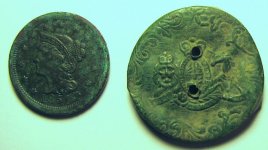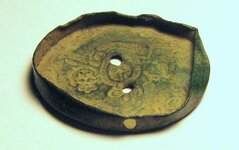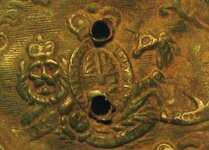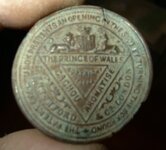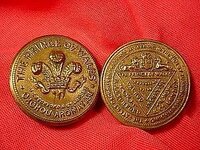As you can see, this item has two holes like it was made into a button. It also has a hole in the edge, though, which makes me wonder if it was used for something else. It was found near furtrade items and I assume it was Native drilled. The bigger question to me is what was it originally. I can't make out all the letters yet, but one word is ROI. It looks like a lion and a unicorn. I can do better pics with natural light tommorrow if needed. Thanks for any help.
Navigation
Install the app
How to install the app on iOS
Follow along with the video below to see how to install our site as a web app on your home screen.
Note: This feature may not be available in some browsers.
More options
You are using an out of date browser. It may not display this or other websites correctly.
You should upgrade or use an alternative browser.
You should upgrade or use an alternative browser.
holed French? item
- Thread starter scratcher
- Start date
Montana Jim
Gold Member
It looks like a button that lost it's back, or some other item that was made into a make-shift button... or even cooler, a "whizzer" toy.
Interesting about the hole in the edge too...
Interesting about the hole in the edge too...
Upvote
0
72cheyenne
Bronze Member
- Dec 6, 2004
- 1,463
- 25
- Detector(s) used
- Minelab E-trac, White's M6, White's 6000di/pro
- Primary Interest:
- All Treasure Hunting
I'm guessing it is a lid that has been made into a whizzer. I would imagine the hole on the side gave it more "whiz". 

Upvote
0
Montana Jim
Gold Member
The lid (or whatever) is very similar or is a stylized Coat of Arms for this description:
"The TRUE Israel People have, on their "Coat-of-Arms", a Lion and a Unicorn which is shown as a white horse "rampant" with one horn. The amber Lion "rampant" on the left-side is the emblem of the two-tribed "House of Judah" and the Unicorn or white Wild-Ox "rampant" on the right-side is the emblem of the ten-tribed "House of Israel", collectively making the 12-tribed "Kingdom of Israel"."
... and is all over the google search images pages.
I think it's a generalized design.
"The TRUE Israel People have, on their "Coat-of-Arms", a Lion and a Unicorn which is shown as a white horse "rampant" with one horn. The amber Lion "rampant" on the left-side is the emblem of the two-tribed "House of Judah" and the Unicorn or white Wild-Ox "rampant" on the right-side is the emblem of the ten-tribed "House of Israel", collectively making the 12-tribed "Kingdom of Israel"."
... and is all over the google search images pages.
I think it's a generalized design.
Upvote
0
- Thread starter
- #5
OK, I found this also on wiki
'The Lion and the Unicorn are symbols of the United Kingdom. They are properly speaking heraldic supporters, appearing in the full Royal coat of arms of the United Kingdom. The lion stands for England and Wales[citation needed] and the unicorn for Scotland. The combination therefore dates back to the 1603 accession of James I of England who was already James VI of Scotland.'
Thanks for getting me started, Jim
I'm going to see if I can figure out why it appears to be in French. Thanks again
'The Lion and the Unicorn are symbols of the United Kingdom. They are properly speaking heraldic supporters, appearing in the full Royal coat of arms of the United Kingdom. The lion stands for England and Wales[citation needed] and the unicorn for Scotland. The combination therefore dates back to the 1603 accession of James I of England who was already James VI of Scotland.'
Thanks for getting me started, Jim
I'm going to see if I can figure out why it appears to be in French. Thanks again
Upvote
0
Montana Jim
Gold Member
I don't see anything "French" about it... I do see a victorian style...
Upvote
0
- Thread starter
- #7
Jim, if you read my post I noted that I thought one of the words on the item was ROI, which I think if I remember correctly is French for King. After researching, I realize I must not be seeing it correctly. It must be DROIT. It is the British Royal Coat of Arms, I believe. Evidently it was first used when England and Sottland joined. I'm going to try and figure out when the current motto version was first used.
Upvote
0
- Thread starter
- #8
From wiki:
The motto is French for "God and my right" (a fuller version of the motto is also quoted as "God and my right shall me defend").[4] Originally spelled Dieut et mon droict in early Modern French, the t in Dieut and c in droict were later dropped in accordance with present French orthography.[citation needed]
For the Royal coat of arms of the Kingdom of England to have a French rather than English motto was not unusual, given that Norman French was the primary language of the English Royal Court and ruling class following the rule of William the Conqueror of Normandy and later the Plantagenets. Another Old French phrase also appears in the full achievement of the Royal Arms. The motto of the Order of the Garter, Honi soit qui mal y pense ("shame upon him who thinks evil of it"), appears on a representation of a garter behind the shield. Modern French spelling has changed honi to honni, but the motto has not been updated.
learning alot here
Could this be a snuff box lid ?
? 
The motto is French for "God and my right" (a fuller version of the motto is also quoted as "God and my right shall me defend").[4] Originally spelled Dieut et mon droict in early Modern French, the t in Dieut and c in droict were later dropped in accordance with present French orthography.[citation needed]
For the Royal coat of arms of the Kingdom of England to have a French rather than English motto was not unusual, given that Norman French was the primary language of the English Royal Court and ruling class following the rule of William the Conqueror of Normandy and later the Plantagenets. Another Old French phrase also appears in the full achievement of the Royal Arms. The motto of the Order of the Garter, Honi soit qui mal y pense ("shame upon him who thinks evil of it"), appears on a representation of a garter behind the shield. Modern French spelling has changed honi to honni, but the motto has not been updated.
learning alot here

Could this be a snuff box lid
 ?
?
Upvote
0
D
[email protected]
Guest
Scratcher,
It might be Latin. Try seeing if the phrase "Honi Soit Qui Maly Pense" fits into your item.
I have a similar lid that I will try to dig out. It doesn't have the two holes like yours, but I think I know that design. The lid I am thinking of is usually mangled when I find one but I think I may have a whole one in my collection.
I'll go look.
Nice finds!
Dave.
Sorry, I didn't notice that you already thought of that phrase.
It might be Latin. Try seeing if the phrase "Honi Soit Qui Maly Pense" fits into your item.
I have a similar lid that I will try to dig out. It doesn't have the two holes like yours, but I think I know that design. The lid I am thinking of is usually mangled when I find one but I think I may have a whole one in my collection.
I'll go look.
Nice finds!
Dave.
Sorry, I didn't notice that you already thought of that phrase.
Upvote
0
D
[email protected]
Guest
The example that I have like yours is mangled but here is a similar lid that may help in figuring out what it may have contained. I hope the picture is legible.
I have to run out the door but I will answer questions later.
Dave.
P.S. The company name is: R. Letchford & Co. London
I have to run out the door but I will answer questions later.
Dave.
P.S. The company name is: R. Letchford & Co. London
Attachments
Upvote
0
- Thread starter
- #15
I think the hole in the edge was for dispensing the mints. Thanks MJ and Dave. I appreciate you leading me in the right direction. I'm going to have to change my assumption about Native drilled. They were for the most part out of my area by 1850. I would guess this may be a little later....
Solved in my opinion...
Solved in my opinion...
Upvote
0
- Thread starter
- #16
Well now I'm not so sure I should have marked this solved. I e-mailed pics to Ben Swanson who is the only 'expert' on cachou boxes I could find and he didn't think it was. He said he didn't know what else it could be, though. I know this probably isn't anything special but would like as much info as possible. Thanks for any input.
Upvote
0
ivan salis
Gold Member
- Feb 5, 2007
- 16,794
- 3,810
- 🏆 Honorable Mentions:
- 1
- Detector(s) used
- delta 4000 / ace 250 - used BH and many others too
cachou * is a type of french licorice flavored candy / breath mint invented in france in 1880 -- its a container lid - the side hole could be lined up with a hole in the container for shaking one out of the container --sort of a 1880's licorice flavored -- tic tac type mint
Upvote
0
Top Member Reactions
-
 3363
3363 -
 1891
1891 -
 1864
1864 -
 1151
1151 -
 1086
1086 -
 868
868 -
 850
850 -
 840
840 -
 829
829 -
 760
760 -
 754
754 -
 552
552 -
 525
525 -
 494
494 -
 441
441 -
 426
426 -
E
417
-
 402
402 -
 401
401 -
 393
393
Users who are viewing this thread
Total: 2 (members: 0, guests: 2)


